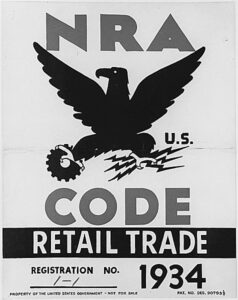Ever since I founded The Future of Freedom Foundation 34 years ago, I have argued that what we need to do to restore freedom in America is immediately end all infringements on freedom. In other words, if there was a button that could be pushed that would bring a sudden and immediate end to all welfare-state, regulatory, and warfare-state programs, I would not hesitate to push it.
Over the years, I have received two major critiques of my position: (1) It would produce chaos by suddenly ending economic programs that have become an integral part of American society; and (2) There would be people dying in the streets who have become dependent on government largess.
Permit me to set forth two examples that address those two points.
The NRA
In June 1933, the Franklin D. Roosevelt administration enacted a program called the National Industrial Recovery Act, which was administered by a new agency called the National Recovery Administration (NRA). It was a fascist program that was straight out of the playbook of Benito Mussolini, the fascist dictator of Italy. It called for American businesses and industries to combine into cartels and then vested them with powers to curtail competition and set their own wages and prices. The program was totally contrary to the principles of a free-market economy.
The emblem of the NRA was the infamous “Blue Eagle.” American businesses, including those at the local retail level, were expected to be good Americans and display the Blue Eagle in their storefront windows. If a business refused, it would be subjected to patriotic boycotts and social ostracism from the president’s supporters.
It’s probably worth pointing out that the NRA was run with an iron fist by a retired U.S. army general, Gen. Hugh Johnson, whose nickname was “Iron Pants.” According to Wikipedia, he was “domineering, abusive, outspoken, and unable to work harmoniously with his peers.”
By 1934, it had become clear that FDR’s fascist program was proving to be an economic disaster. Americans, including businessmen, were turning against it.
However, it was argued that because the program had become an integral part of America’s economy, it could not be suddenly ended. Millions of people had become dependent on it. To suddenly end the program would result in massive economic chaos. Therefore, it was said, the program should be gradually phased out over a long period of time.
In other words, people were making the same argument back then that people make today about my position favoring the immediate end of all welfare-warfare infringements on liberty.
And then it happened. The U.S. Supreme Court “pushed the button” on May 27, 1935, which was two years after the NIRA was enacted. On that day, the Court, in a unanimous decision, declared that the NIRA was in violation of the U.S. Constitution, which wasn’t too surprising given that the Constitution did not authorize the enactment of fascist programs.
On that day, the NIRA came to a sudden and immediate end. No gradualism. No phaseout. Once the Court announced its decision, the NIRA was over.
The result? Chaos? Crisis? Nope. Instead, the Court’s decision to “push the button” produced an immediate revival of economic activity and prosperity.
Slavery
A second example: American slavery. Undoubtedly, there were those who argued that it would be cruel and inhumane to suddenly and immediately end slavery. Slaves didn’t have many job skills. They didn’t know how to open businesses. They had no education. They were penniless. There were black seniors. There were slaves who had cancer and other serious illnesses. No dwellings. No Social Security, Medicare, or Medicaid or other government assistance to draw on. The slaves had nothing but the clothes on their backs. Therefore, it was necessary and humane to gradually end slavery over a long period of time so that the slaves could be adequately prepared for it.
But if the slaves were asked what they thought about this gradualism plan, my hunch is that 100 percent of them would have said, “Bull on that. We want freedom now. We fully realize that we are penniless, have no dwellings, have few job skills, and don’t know how to open businesses. We also know that there are many black seniors and ill people among us. But no matter how difficult life might be, we will manage. We want our freedom now, not later on.”
Then on April 9, 1865, Lee surrendered to Grant at Appomattox, which, for all practical purposes, brought an immediate and sudden end to slavery. The “button” had been pushed.
What was the result? Immediately, blacks began opening businesses, engaging in economic enterprise, going to work for others, acquiring dwellings, and taking care of each other (oftentimes with the assistance of whites), on a purely voluntary basis. They didn’t die in the streets, as the gradualists had predicted.
Was it difficult? Of course it was. After all, much of the entire South was destroyed. Even many whites were left penniless and homeless, especially given Union Gen. William Tecumseh Sherman’s vicious war crimes against women, children, and other non-combatants. Naturally, blacks were in much worse condition than whites. But they managed to survive and prosper. In fact, one of the major reasons for the later enactment of Jim Crow laws was to protect white businessmen from the competition of former slaves who were outcompeting them in the marketplace.
Another fascinating aspect of black liberation was with respect to education. Almost immediately, blacks began forming schools because they understood the value of education. They didn’t need to be ordered to do so by the state. Some of the colleges and universities that they founded in the aftermath of the Civil War are still standing today as Historically Black Colleges and Universities.
Freedom and free markets bring economic prosperity and harmony to a society. And they also bring out the best in mankind. Push the button and immediately free American people from our welfare-warfare state serfdom.




